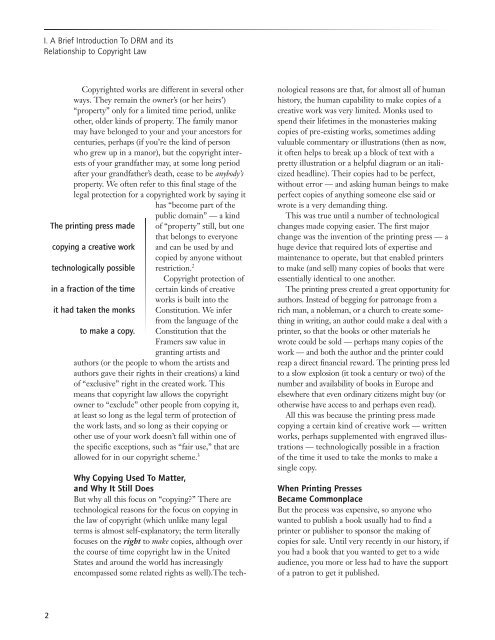What Every Citizen Should Know About DRM, aka - Public Knowledge
What Every Citizen Should Know About DRM, aka - Public Knowledge
What Every Citizen Should Know About DRM, aka - Public Knowledge
You also want an ePaper? Increase the reach of your titles
YUMPU automatically turns print PDFs into web optimized ePapers that Google loves.
I. A Brief Introduction To <strong>DRM</strong> and itsRelationship to Copyright LawCopyrighted works are different in several otherways. They remain the owner’s (or her heirs’)“property” only for a limited time period, unlikeother, older kinds of property. The family manormay have belonged to your and your ancestors forcenturies, perhaps (if you’re the kind of personwho grew up in a manor), but the copyright interestsof your grandfather may, at some long periodafter your grandfather’s death, cease to be anybody’sproperty. We often refer to this final stage of thelegal protection for a copyrighted work by saying ithas “become part of thepublic domain” — a kindThe printing press made of “property” still, but onethat belongs to everyonecopying a creative work and can be used by andcopied by anyone withouttechnologically possible restriction. 2Copyright protection ofin a fraction of the time certain kinds of creativeworks is built into theit had taken the monks Constitution. We inferfrom the language of theto make a copy. Constitution that theFramers saw value ingranting artists andauthors (or the people to whom the artists andauthors gave their rights in their creations) a kindof “exclusive” right in the created work. Thismeans that copyright law allows the copyrightowner to “exclude” other people from copying it,at least so long as the legal term of protection ofthe work lasts, and so long as their copying orother use of your work doesn’t fall within one ofthe specific exceptions, such as “fair use,” that areallowed for in our copyright scheme. 3Why Copying Used To Matter,and Why It Still DoesBut why all this focus on “copying?” There aretechnological reasons for the focus on copying inthe law of copyright (which unlike many legalterms is almost self-explanatory; the term literallyfocuses on the right to make copies, although overthe course of time copyright law in the UnitedStates and around the world has increasinglyencompassed some related rights as well).The technologicalreasons are that, for almost all of humanhistory, the human capability to make copies of acreative work was very limited. Monks used tospend their lifetimes in the monasteries makingcopies of pre-existing works, sometimes addingvaluable commentary or illustrations (then as now,it often helps to break up a block of text with apretty illustration or a helpful diagram or an italicizedheadline). Their copies had to be perfect,without error — and asking human beings to makeperfect copies of anything someone else said orwrote is a very demanding thing.This was true until a number of technologicalchanges made copying easier. The first majorchange was the invention of the printing press — ahuge device that required lots of expertise andmaintenance to operate, but that enabled printersto make (and sell) many copies of books that wereessentially identical to one another.The printing press created a great opportunity forauthors. Instead of begging for patronage from arich man, a nobleman, or a church to create somethingin writing, an author could make a deal with aprinter, so that the books or other materials hewrote could be sold — perhaps many copies of thework — and both the author and the printer couldreap a direct financial reward. The printing press ledto a slow explosion (it took a century or two) of thenumber and availability of books in Europe andelsewhere that even ordinary citizens might buy (orotherwise have access to and perhaps even read).All this was because the printing press madecopying a certain kind of creative work — writtenworks, perhaps supplemented with engraved illustrations— technologically possible in a fractionof the time it used to take the monks to make asingle copy.When Printing PressesBecame CommonplaceBut the process was expensive, so anyone whowanted to publish a book usually had to find aprinter or publisher to sponsor the making ofcopies for sale. Until very recently in our history, ifyou had a book that you wanted to get to a wideaudience, you more or less had to have the supportof a patron to get it published.2





